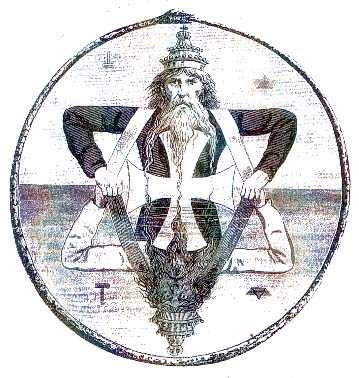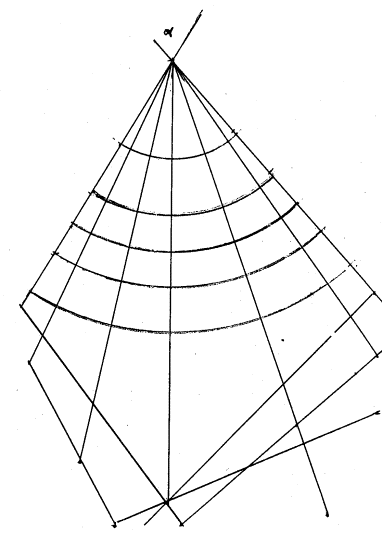Consciousness, Literature and the Arts
Archive
Volume 4 Number 1, April 2003
_______________________________________________________________
Illusion and creativity, where does fascination come from ?
By
Abstract
The interrelations of rational and emotional aspects of creativity, the role of well-developed symbolic thinking are discussed. The considered examples pertain to mathematics, medieval architecture, painting of Renaissance, and religion.
Introduction
Descartes
said : « Cogito ergo sum »
« I think therefore I am »,
but is this reality ? From the Indian philosopher Inayat Khan we
can read : « Reason is the illusion of reality » (Khan, 1974).
Here are some more questions : Are animals unreal because they cannot
apparently think ? Are plants and all the surrounding world unreal ?
Is suffering unreal ? What is reality ? What is illusion ?
We
do not actually know, except that we have in common a feeling that the world
we are living in gives us the illusion of being real. So from our vantage
point we live in a real world, and in this so- called real world creation is
permanent. We are integrated in
the endless cycles of the universe metamorphosis. As a matter of fact as soon as simple or compound elements appear there is either
repulsion or attraction, fight or love and as a result, there is death for
many, and union and multiplication for many others. Besides we notice that out
of death, through the chemical process of decomposition other bodies appear
and all this forms a chain that goes on and on...
Creation
in our world is permanent.
Creation and Creativity
Now,
what do creation and creativity have in common and what makes them
different ? For creation as well as for creativity one needs at least two
elements to create something new, and the bigger the number of connected
elements, the more elaborate the creation is.
But
for creativity we need more. First, we have to be conscious of what we are
doing, then we have to be aware that what we are elaborating did not
exist before and feel that it should exist now.
Can
we achieve all this out of reason, out of the studies dealing with
consequences and effects ?
To
my mind, this is not enough, there must also be a strong appeal that has
nothing to do with logic, that has something to do with a part of our being
for which there is neither shape nor form, for which, no precise definition
can be given. This appeal seems to be at the same time, basic and
transcendental. Basic because it is vital and creativity like creation is
permanent, but also transcendental because we feel that what we are doing should be perfect. Unfortunately very often by lack of means,
possibilities, energy and so on… we are far from reaching that perfection
and here doubt comes. Yet there are moments when emotion arises like a
tuning-in with the sound-post of the Great Universal Cosmic Soul, and then,
all of a sudden, a gift, an illumination may invade us.
When
this occurs, why not consider it, on the one hand, as the fruit of all
our former studies and knowledge, and on the other hand, as the result of this
wonderful emotion ?
A / Pascal’s
triangle
To begin with, I will try to
represent this through Pascal’s arithmetic triangle. But a question could
arise, why a triangle ? As a matter of fact, everyone knows that
parallels join in the infinite and from this virtual connection point an
infinity of triangles can spring forth like the rays of the sun.
In
his « Thoughts » Pascal wrote that Man is between two abysses : Infinity and Void, he also added :
« All the visible world is but an
imperceptible dot in Nature’s Spacious Bosom. No idea can approach it. No
matter how much we inflate our concepts, we only give birth to atoms compared
with the reality of things. It is a sphere whose center is everywhere, whose
circumference is nowhere... Therefore let us know our limits ; we are
something, we are not everything ».
Keeping
this in mind, we may nevertheless, at our level, imagine that this infinity of
infinite centers converge towards The
Center which could be the Principle
of All. Let us call this point ALPHA
and choose one of the possible triangles.
Pascal
with his arithmetic triangle defined a table in which every number is worth
the sum of the one preceding it on the same line and of the one above it in
the same column.
If
we represent this under the shape of an isoceles triangle we notice that :
1/
if for every new number on each side of the triangle we draw a parallel to the
other side, as the triangle gets bigger, the numbers inside get bigger and
bigger too ;
2/
the biggest numbers are to be found at the converging points which are right
under the summit of the triangle ;
3/
if we join two equidistant points situated on the two sides of the triangle,
for example B and C, we create two new triangles B Alpha C and B Béta C,
B
Béta C being
the exact replica of B Alpha C.

We
can then deduce that all the elements contained in the second triangle are
already included in the first one, in other words, the principle of unity is
infinitely repeated in its elements in General and in Particular.
In
a more colloquial language we would say that all the elements of the sea are
contained in a drop of water, although a drop of water is not all the sea.
Now,
as I said before, the biggest numbers are to be found at the converging points
which are right under Alpha, that is
to say under the top of the triangle. This
is most important. On the one hand, these new numbers are the sum of the
two preceding numbers which themselves are the biggest ever met up to that
moment, and we may say that they are the result of a long series of deductions
made at least on two different sides ; but, on the other hand, as they
are on direct line with point Alpha,
we may also say that suddenly a direct connection has been made with this
point and something which had not been seen before suddenly appears like a
flash of lightning.
Let
us remember Archimedes when all of a sudden, he cried « Eurêka »,
or this spiritual man who said talking about God : « He was there and I did not know it »
So,
here we have the connection of two different sorts of knowledge : rational knowledge and let us say spiritual-emotional-knowledge.
B / Solomon’s seal
The
idea of a triangle is found in the Christian religion where God is often
represented as a triangle ; it is also to be found in the Jewish
religion, in Solomon’s seal, but this time there are two triangles instead
of one.
Those
two triangles are like the two opposite triangles B
Alpha C and B Béta C
that we drew before, except that part of the upper triangle goes down
into the lower one, and part of the lower triangle goes up into the upper one.
Here
is a representation of that seal where we can very clearly see that the
triangle is the image of God ; the upper triangle being the God
of Light, and the lower one its reflection, the God of Illusion.

These
two triangles are framed within a circle (the snake biting its own tail)
symbolizing eternity.
It
is really interesting to look carefully at this picture. The god of illusion
seems to be the exact reflection of the god of light, and yet there are
important differences :
-
Both gods are crowned, but for the god of light, on top of his crown we
can see a cross, there is not such a cross on top of the crown for the god of
illusion.
-
One has a white face and black clothes, the other has a dark face and
white clothes ; that could be compared with the two sides of the same
medal or with an exoteric reading and an esoteric one.
-
The most striking difference comes from the look. The god of light’s
look is perfectly clear and wilful, whereas the god of illusion has a lost and
wild look. All this reminds me of Saint John of the Cross who, when talking
about our life on earth, used to say that it was a «
dark night ».
Then
the question shall arise, in such a context can there be « Hope » ?
Let
us now look at the picture again and this time let us examine the gods’
beards. They are very long with a main branch and two thinner branches and
they precisely join on the demarcation line between the two worlds : the
world of light and the world of illusion.
There,
a Cross appears, symbolizing the
junction between the two worlds, first a vertical junction which, once
achieved, spreads out horizontally. This cross-junction may be considered as
the tuning-in with the Great Universal
Soul.
When,
among the infinity of infinite possibilities, a junction has been made, it
does not any longer belong to the person who did it, but spreads out all over
and belongs to all.
